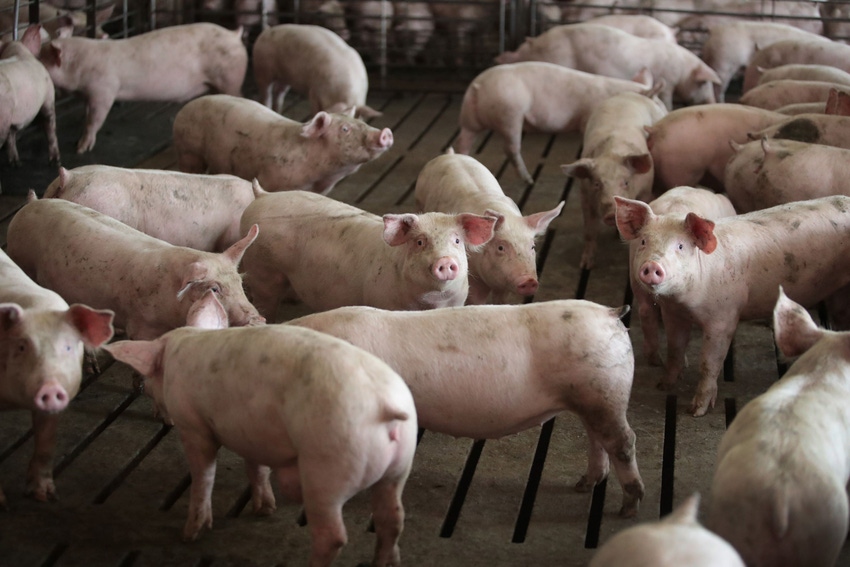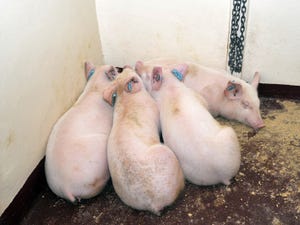LMIC, Farm Bureau call for USDA-NASS reconsideration of report cuts
Changes proposed are significant and will impact all on some level.

The Livestock Marketing Information Center (LMIC), a cooperative non-profit devoted to providing educational outreach and information regarding the livestock markets, sent a letter to the U.S. Department of Agriculture’s National Agricultural Statistics Service (NASS) expressing concern over plans to cancel critical reports and modify programs related to government-issued livestock data.
LMIC’s membership consists of 28 land-grant universities, eight USDA agencies and 14 associate members who all live and work in the livestock space. LMIC is considered a leading public-private organization of agricultural economists and engaged stakeholders that use USDA data on a daily basis.
“The recent announcements made by USDA-NASS has left us gravely concerned both in areas of canceled reports and announced program changes to the livestock data. The cancellation of the July Cattle inventory report and proposed changes to the January Cattle report would create a major negative impact on the cattle industry and industry participants such as LMIC members and subscribers.
“The July cattle inventory report provides critical breeding herd and heifer retention information for the beef supply chain. It guides decisions for cow-calf producers, cattle growing and finishing operations, and packers, as well as informs the market participants who are engaging in risk management activities.
“Additionally, the dairy heifer replacement number recently hit a 20-year low, raising questions about structural change in the dairy industry, the use of reproduction technology, and dairy-born calves entering the beef supply chain,” stated LMIC in its letter signed by its director Katelyn McCullock.
The group added that, “The cancellation of the July Cattle report would have a direct negative impact to the LMIC membership by making forecasters less adaptive to changing supply conditions, introducing unknown variables (calf crop and heifer replacement) into the marketing pipeline, and creating greater uncertainty. Risk managers and bankers will struggle with client recommendations beyond a one-year timeline, and policy makers will need to create ever wider safety nets to encompass new market uncertainty.”
LMIC pointed out that the timing of canceling the July Cattle report could not be worse given the current dynamics of the U.S. cattle industry.
“The U.S. cattle herd has been contracting over the last several years and the July Cattle report is a key piece of data regarding when the industry will transition from contraction to an expansion phase. The July report also represents the first look at the calf crop for the year. These transitions can have swift pricing implications and the data are critical to helping our members prepare cow-calf and feedlot operations for what’s next. If these changes are made, we can expect more volatility in prices and greater uncertainty in our cattle and beef markets,” said the group.
In its letter, LMIC strongly encouraged USDA-NASS not to cancel county level estimates. These are extremely important to both extension and research efforts across the U.S. Extension state specialists are often tasked with delivering targeted programing whether it be for insurance programs, natural disaster information, or outlook, among other things. County level estimates are critical for these specialists to understand the counties to which they are speaking. The data are incredibly important for those who have been tasked with estimating natural disaster impacts for a particular region, where state level data is insufficient.
In addition to its changes to the cattle reports, USDA-NASS has announced, the following modifications:
Hogs and Pigs
NASS plans to reduce the number of published states for December Hogs and Pigs from 50 states to 16 states. The 16 published states will be Colorado, Illinois, Indiana, Iowa, Kansas, Kentucky, Michigan, Minnesota, Missouri, Nebraska, North Carolina, Ohio, Oklahoma, Pennsylvania, South Dakota, and Texas. The 34 non-published states will be accounted for as Other States.
Milk Production
NASS plans to reduce the number of published states for quarterly Milk Production from 50 states to 33 states. The 17 non-published states will be Alabama, Alaska, Arkansas, Connecticut, Delaware, Hawaii, Louisiana, Massachusetts, Mississippi, Montana, New Hampshire, New Jersey, North Dakota, Rhode Island, South Carolina, West Virginia, Wyoming. The 17 non-published states will be accounted for as Other States.
Cattle on Feed
NASS plans to remove Minnesota as a published state in the monthly Cattle on Feed report. Minnesota will be accounted for with Other States.
Broiler Hatchery
NASS plans to remove Florida and Louisiana from the published states in the weekly Broiler Hatchery report. Florida and Louisiana will be accounted for with Other States.
Chickens and Eggs
NASS plans to remove Maryland, South Dakota, and Virginia from a published state in the monthly Chickens and Eggs report. These 3 states will be accounted for with Other States. NASS plans to remove Louisiana, Maryland, Massachusetts, Montana, South Dakota, Virginia, and West Virginia from a published state in the annual Chickens and Eggs report. These states will be accounted for with Other States.
Goats
NASS plans to reduce the number of published states for Goats – Meat from 28 to 26 states. Nebraska and Wisconsin will be published states. The 4 non-published states will be Louisiana, New York, Washington, and West Virginia although will be accounted for in Other States.
NASS plans to increase the number of published states for Goats – Milk from 29 to 30 states. Nevada will be added as a published state.
“Other program changes under USDA NASS’s program review are also less than ideal particularly for longer term research studies and state extension programing. The state-level data for all 50 states in the January report is vital to understanding livestock dynamics in those states. The January report is the only by-state estimate for beef and dairy heifer replacements and calf crop data. Many of LMIC’s stakeholders are specifically state based and even though the data is included in the annual figure, not having state specific data makes it more difficult from a research and extension personnel point of view,” said the group.
AFBF to USDA: Restore NASS Surveys
The American Farm Bureau Federation also urged USDA to reverse its decision to cancel livestock and crop surveys that are crucial to the success of America’s farmers and ranchers.
AFBF President Zippy Duvall sent a letter to USDA to emphasize the importance of the surveys, particularly the July cattle report. “NASS’ two reports regarding the total U.S. cattle inventory, published on Jan. 31 and in late July, give farmers, ranchers, researchers and other data users a full picture of supplies in the U.S. cattle sector at the beginning and in the middle of each year. This allows for a fair assessment of the cattle market for the next six months. Eliminating the mid-year report puts the market in the dark for the second half of the year, removes market transparency and increases market volatility. Data will only be available to those who can afford to collect it, further threatening competition in the packing sector.”
AFBF noted farmers are price takers not price makers and have no control over the markets in which their livestock is sold. Market transparency is essential where four companies control 85% of the cattle market.
The organization also pointed out the loss of the Objective Yield Survey for cotton may also increase the level of uncertainty throughout the summer and early fall for cotton markets, and the elimination of county yield estimates will undercut the research upon which risk management programs, including crop insurance, are based.
“Eliminating county-level yield and production data for crops and livestock will also severely impact research from our land-grant institutions and only place the U.S. farther behind its trade competitors,” President Duvall wrote. “Recent research by USDA’s Economic Research Service showed that the U.S. trails its global competitors in public agricultural research.”
Read the full AFBF letter here.
LMIC supporters
The following LMIC members, subscribers, and industry supporters, put their signature on the LMIC letter to USDA-NASS:
Altin Kalo, Daily Livestock Report
Amber Roberts, AgWest Farm Credit
Andy Gottschalk, RJ O’Brien and Associates
Anna Miller, Western Livestock Journal
Andrew Griffith, University of Tennessee
Bernt Nelson, American Farm Bureau Federation
Brett Wilder, University of Idaho
Bob Wilson, HedgersEdge, LLC
Charles Wallace, Western Livestock Journal
Christopher Bastian, University of Wyoming
David Anderson, Texas A&M University
Derrell Peel, Oklahoma State University
Don Close, Terrain Ag
Elliott Dennis, University of Nebraska
Erica Sanko, American Sheep Industry Association
Erin Nazetta, Broadview Capitol Holdings
Greg Henderson, Drovers/Farm Journal
Hernan Tejeda, University of Idaho
Jennifer Shike, Farm Journal’s PORK
Jim Mintert, Purdue University
Josh Maples, Mississippi State University
Kenny Burdine, University of Kentucky
Len Steiner, Steiner Consulting
Mark Barnett, Livestock Marketing Association
Max Runge, Auburn University
Michael Popp, University of Arkansas
Michael Schuldt, Southeastern Montana Livestock Association
Mike Sands, MBS Research
Patrick Linnell, Cattlefax
Rob Fox, CoBank
Rob Ziegler, University of Wyoming
Russell Tronstad, University of Arizona
Sarah Muirhead, Feedstuffs and BEEF Magazine
Stephen Koontz, Colorado State University
Tim Petry, North Dakota State University
Ty Neff, Express Markets, Inc
Zach Gihorski, National Council of Farmer Cooperative
About the Author(s)
You May Also Like



